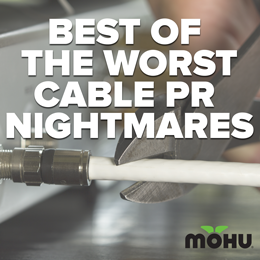Pay TV is the gift that keeps on giving. And giving. And giving, over and over, until the end of time (or when your contract runs out … whichever happens first). By “giving,” we mean “taking.”
You should know by now about how cool our HDTV antennas are, but we believe cordcutting is a mantra to be shared by anyone whether you own a Mohu product or not. If you’re not in the know, check out some of these reasons why you may want to avoid corporate pay-TV providers and their associated cable PR nightmares.
Pay TV is a PR nightmare
What’s that, you say? Comcast is charging customers without a reason to?
Comcast says a billing system upgrade caused the problem for a “small amount” of Pennsylvania customers; by the time the company realized what happened, the bills already had been printed and processed.
Comcast service is so poor and overpriced that their own employees are sharing ways to lower your bill.
Comcast, my cable company, has an annoying habit of unexpectedly raising my bill for cable internet service. When I moved to the Washington, DC, area in 2013, I signed up for Comcast’s Xfinity broadband service at an introductory rate of $41.99 per month. In January, the price went up to $57.99. Then, in May, my bill went up again — to $74.95. That was almost double the rate I had signed up for.
Their installation services are so unreliable that they proudly boast about having an app to track where your cable guy is. Really? This seems silly considering appointments should be kept if scheduled for a certain time. The big deal here is that you’ll be notified 30 minutes before your technician will arrive — no more 4-hour windows! Why is this to be celebrated?
Comcast CEO Brian Roberts demonstrated a new app last week that lets customers track a technician’s schedule in in real time because “you should know when we are arriving,” as according to Charlie Herrin, Senior Vice President of Customer Experience at Comcast.
Plus, let’s not forget the now infamous Comcast customer service call…
Shady tactics
Their upgrades, up-sells and products are borderline scammy.
While Comcast is pushing new modem/router gadgets at subscribers around the country, some consumers are complaining that they are being tricked into ordering new modem/routers that come with a monthly fee.
Examples of their terrible customer service often leak to the internet.
Lo and behold, he got transferred to a line that kept ringing and then disconnected him. Again.
Who else loves their cable bills? Show of hands!
Guess what? Your bills are going to keep going up, up, up!
Time Warner Cable will soon charge its 15 million customers for watching sports as the major cable provider tries compensating for the rising costs of broadcasting local channels and athletic programming.
Their bundles are no longer viewed as the “best deal” available, especially since there are so many stations that nobody wants to watch — much less pay for! ESPN is at the center of this debate.
“Frustrated with rising cable bills, notorious customer service and TV bundles that include dozens of unwanted channels, more customers are now choosing to ‘cut the cord’ with providers and stream their content online via services such as Netflix and Amazon,” wrote Chen Zhao and Connor O’Callaghan, the study’s authors.
Lastly, the townsfolk are fighting back to retain their independence from oppressive dictators like Comcast (speaking of which, anyone seen “The Interview”?). Communities need affordable connectivity, plainly put.
It’s easy to see why: The big providers often refuse to build networks in low-income or rural communities where potential customers can’t afford to pay their sky-high rates.
Keep in mind this is a very, very short list of fiascos brought to light by pay TV’s own business models … and most of these examples are from the latter half of this year alone. We’ll continue fighting to provide access to free TV, and we hope you’ll continue fighting to preserve freedom of choice.




